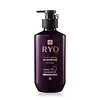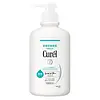What's inside
What's inside
 Key Ingredients
Key Ingredients

No key ingredients
 Benefits
Benefits

 Concerns
Concerns

 Ingredients Side-by-side
Ingredients Side-by-side

Water
Skin ConditioningSodium Laureth Sulfate
CleansingAmmonium Lauryl Sulfate
CleansingGlycerin
HumectantCocamide Mea
EmulsifyingParfum
MaskingDisodium Laureth Sulfosuccinate
CleansingLauryl Hydroxysultaine
CleansingCaffeine
Skin ConditioningPPG-3 Caprylyl Ether
SolventAlcohol Denat.
AntimicrobialPhenoxyethanol
PreservativeSodium Benzoate
MaskingCetyl Alcohol
EmollientMenthol
MaskingGuar Hydroxypropyltrimonium Chloride
Skin ConditioningCitric Acid
BufferingSodium Salicylate
PreservativeCaprylic/Capric Triglyceride
MaskingTrihydroxystearin
Skin ConditioningSodium Citrate
BufferingDicaprylyl Ether
EmollientTetrasodium EDTA
Butylene Glycol
HumectantMalt Extract
Skin ProtectingDisodium EDTA
Linalool
PerfumingPEG-45m
HumectantGlyceryl Stearate
EmollientMentha Arvensis Leaf Extract
MaskingBenzyl Salicylate
PerfumingHexyl Cinnamal
PerfumingBenzyl Benzoate
AntimicrobialGeraniol
PerfumingAlpha-Isomethyl Ionone
PerfumingHydrolyzed Corn Starch
HumectantCaprylyl Glycol
EmollientPinus Densiflora Leaf Extract
Antimicrobial1,2-Hexanediol
Skin ConditioningDehydroacetic Acid
PreservativePanax Ginseng Extract
AntioxidantPanax Ginseng Root Extract
EmollientSilica
AbrasiveZingiber Officinale Root Extract
MaskingEthylhexylglycerin
Skin ConditioningTocopherol
AntioxidantOryza Sativa Extract
AbsorbentImperata Cylindrica Root Extract
Skin ConditioningScutellaria Baicalensis Root Extract
AstringentSesamum Indicum Seed Extract
Skin ConditioningLonicera Japonica Flower Extract
Skin ConditioningCalendula Officinalis Flower Extract
MaskingTribulus Terrestris Fruit Extract
Skin ConditioningCamellia Japonica Seed Oil
EmollientCamellia Sinensis Seed Oil
HumectantPEG-150 Pentaerythrityl Tetrastearate
EmulsifyingPPG-2 Hydroxyethyl Cocamide
EmulsifyingPolygonum Multiflorum Root Extract
Skin ConditioningWater, Sodium Laureth Sulfate, Ammonium Lauryl Sulfate, Glycerin, Cocamide Mea, Parfum, Disodium Laureth Sulfosuccinate, Lauryl Hydroxysultaine, Caffeine, PPG-3 Caprylyl Ether, Alcohol Denat., Phenoxyethanol, Sodium Benzoate, Cetyl Alcohol, Menthol, Guar Hydroxypropyltrimonium Chloride, Citric Acid, Sodium Salicylate, Caprylic/Capric Triglyceride, Trihydroxystearin, Sodium Citrate, Dicaprylyl Ether, Tetrasodium EDTA, Butylene Glycol, Malt Extract, Disodium EDTA, Linalool, PEG-45m, Glyceryl Stearate, Mentha Arvensis Leaf Extract, Benzyl Salicylate, Hexyl Cinnamal, Benzyl Benzoate, Geraniol, Alpha-Isomethyl Ionone, Hydrolyzed Corn Starch, Caprylyl Glycol, Pinus Densiflora Leaf Extract, 1,2-Hexanediol, Dehydroacetic Acid, Panax Ginseng Extract, Panax Ginseng Root Extract, Silica, Zingiber Officinale Root Extract, Ethylhexylglycerin, Tocopherol, Oryza Sativa Extract, Imperata Cylindrica Root Extract, Scutellaria Baicalensis Root Extract, Sesamum Indicum Seed Extract, Lonicera Japonica Flower Extract, Calendula Officinalis Flower Extract, Tribulus Terrestris Fruit Extract, Camellia Japonica Seed Oil, Camellia Sinensis Seed Oil, PEG-150 Pentaerythrityl Tetrastearate, PPG-2 Hydroxyethyl Cocamide, Polygonum Multiflorum Root Extract
Dipotassium Glycyrrhizate
HumectantWater
Skin ConditioningSodium Laureth Sulfate
CleansingLauryl Hydroxysultaine
CleansingC9-11 Alkyl Glucoside
CleansingPPG-10 Lauryl Ether
PPG-3
SolventTrehalose Hydroxypropyltrimonium Chloride
Skin ConditioningBenzyl Benzoate
AntimicrobialCoconut Oil Aminoethoxyethanol Amides
FoamingSodium Cocoyl Glutamate
CleansingCitric Acid
BufferingDiallyldimethyl Ammonium Chloride
Stearoxymethicone/Dimethicone Copolymer
EmollientAlcohol Denat.
AntimicrobialEDTA
Sodium Chloride
MaskingSodium Hydroxide
BufferingOrange Roughy Oil
Skin ConditioningEucalyptus Globulus Oil
Dipotassium Glycyrrhizate, Water, Sodium Laureth Sulfate, Lauryl Hydroxysultaine, C9-11 Alkyl Glucoside, PPG-10 Lauryl Ether, PPG-3, Trehalose Hydroxypropyltrimonium Chloride, Benzyl Benzoate, Coconut Oil Aminoethoxyethanol Amides, Sodium Cocoyl Glutamate, Citric Acid, Diallyldimethyl Ammonium Chloride, Stearoxymethicone/Dimethicone Copolymer, Alcohol Denat., EDTA, Sodium Chloride, Sodium Hydroxide, Orange Roughy Oil, Eucalyptus Globulus Oil
 Reviews
Reviews

Alternatives
Ingredients Explained
These ingredients are found in both products.
Ingredients higher up in an ingredient list are typically present in a larger amount.
Alcohol Denat. is an alcohol with a denaturant property. It is created by mixing ethanol with other additives.
This ingredient gets a bad rep because it is irritating and drying - mostly due to its astringent property. Astringents draw out natural oils in tissue, constricting pores and leaving your skin dried out.
However, alcohol denat. is not all that bad.
Due to its low molecular weight, alcohol denat. tends to evaporate quickly. One study on pig skin found half of applied alcohol evaporated in 10 seconds and less than 3% stayed on skin.
This also helps other ingredients become better absorbed upon application.
Studies are conflicted about whether this ingredient causes skin dehydration. One study from 2005 found adding emollients to propanol-based sanitizer decreased skin dryness and irritation. Another study found irritation only occurs if your skin is already damaged.
Small amounts of alcohol are generally tolerated by oily skin or people who live in humid environments.
The rule of thumb is if this alcohol is near the end of an ingredients list, it will probably not affect your skin much.
Also...
This ingredient has antimicrobial and solvent properties.
The antimicrobial property helps preserve products and increase their shelf life. As a solvent, it helps dissolve other ingredients.
Other types of astringent alcohols include:
Learn more about Alcohol Denat.Benzyl Benzoate is usually created from the condensation of benzoic acid and benzyl alcohol. It is used as a preservative, solvent, and has a floral/balsamic scent in large amounts.
As a preservative, Benzyl Benzoate works against bacteria and fungus. It is often used to treat scabies and lice in medicine.
Solvents are used to keep ingredients together in a product. They can help dissolve ingredients to stable bases or help evenly distribute ingredients throughout the product.
Due to its fragrance, Benzyl Benzoate can be sensitizing and may cause contact dermatitis. It is a known EU allergen. We recommend speaking with a professional if you have any concerns.
Benzyl Benzoate can be naturally found in cranberries and peaches.
Learn more about Benzyl BenzoateCitric Acid is an alpha hydroxy acid (AHA) naturally found in citrus fruits like oranges, lemons, and limes.
Like other AHAs, citric acid can exfoliate skin by breaking down the bonds that hold dead skin cells together. This helps reveal smoother and brighter skin underneath.
However, this exfoliating effect only happens at high concentrations (20%) which can be hard to find in cosmetic products.
Due to this, citric acid is usually included in small amounts as a pH adjuster. This helps keep products slightly more acidic and compatible with skin's natural pH.
In skincare formulas, citric acid can:
While it can provide some skin benefits, research shows lactic acid and glycolic acid are generally more effective and less irritating exfoliants.
Most citric acid used in skincare today is made by fermenting sugars (usually from molasses). This synthetic version is identical to the natural citrus form but easier to stabilize and use in formulations.
Read more about some other popular AHA's here:
Learn more about Citric AcidWe don't have a description for Lauryl Hydroxysultaine yet.
Sodium Laureth Sulfate (SLES) is a foaming, cleansing, and emulsifying ingredient. It is created from palm kernel oil or coconut oil. SLES is not the same as sodium lauryl sulfate. It is much milder and less likely to irritate.
SLES helps create foam in personal products. It also prevents ingredients from separating, helping to elongate the shelf life.
Sodium Laureth Sulfate is a type of sulfate. It can be drying. We recommend speaking with a professional about using this ingredient if you have concerns.
Learn more about Sodium Laureth SulfateWater. It's the most common cosmetic ingredient of all. You'll usually see it at the top of ingredient lists, meaning that it makes up the largest part of the product.
So why is it so popular? Water most often acts as a solvent - this means that it helps dissolve other ingredients into the formulation.
You'll also recognize water as that liquid we all need to stay alive. If you see this, drink a glass of water. Stay hydrated!
Learn more about Water